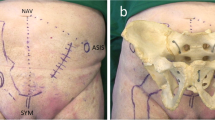Summary
This study demonstrates the importance of a superior approach to acetabulum with intrapelvic osteotomy of the iliac ala in certain fractures of the acetabulum. This study is based on the dissection of 15 formolized and 5 frozen subjects, the surgical treatment of 17 acetabular fractures, and the performances of 2 Chiari-type osteotomies and 2 Salter-type osteotomies. we investigated the gluteus medius muscle and its Pedicle in relation to the iliac ala. Landmarks for the osteotomy lines and the gluteal pedicles are defined in terms of the requirements of different surgical approaches. The superior approach for acetabular fractures was made using a skin incision of Smith-Petersen type. The underlying principle is the performance of an intrapelvic osteotomy of the iliac ala, the anterosuperior part of the ala being tilted outward and backward and pedicled on the gluteal muscles. This provides intra- and extrapelvic exposure of the acetabular walls. The advantages and drawbacks of this route of approach in surgery of the pelvic girdle are discussed in terms of the types of fracture treated and tumoral locations. The anatomic findings are illustrated from traumatology and tumoralpathology. This approach seems particularly suitable for acetabular fractures interrupting the pelvic ring.
Résumé
Cette étude montre l'intérÊt d'une voie d'abord supérieure de l'acétabulum avec ostéotomie endopelvienne de l'aile iliaque dans certaines fractures de l'acétabulum. La dissection de 15 sujets formolés, de 5 sujets congelés, l'abord chirurgical de 17 fractures du cotyle, la réalisation de 2 ostéotomies de type Chiari et de 2 ostéotomies de type Salter ont fourni les bases de ce travail. Nous nous sommes attachés à l'étude du muscle moyen fessier et de son pédicule par rapport à l'aile iliaque. Les repères des traits d'ostéotomie et des pédicules fessiers sont précisés selon les nécessités des différents abords chirurgicaux. La voie d'abord supérieure pour les fractures de l'acétabulum est réalisée par une incision cutanée de type Smith Petersen. Le principe est de pratiquer une ostéotomie endopelvienne de l'aile iliaque, la partie supéro-antèrieure de l'aile iliaque est basculée en dehors et en arrière en restant pédiculisée sur les muscles fessiers ce qui donne un jour endo- et exo-pelvien sur les parois de l'acétabulum. Les avantages et les inconvénients de cette voie d'abord dans la chirurgie du bassin sont discutés en fonction du type de fracture à traiter et des localisations tumorales. Des exemples, en traumatologie et en pathologie tumorale, illustrent nos constatations anatomiques. Ce sont surtout les fractures de l'acétabulum interrompant l'anneau pelvien qui semblent justifier cette voie d'abord.
Similar content being viewed by others
References
Bernard R, Charleux H, Collot F (1957) Abord transiliaque de certaines fractures du cotyle avec luxation intra-pelvienne. Mem Acad Chir 88: 367–369
Carnesale PG, Stewart MJ, Barnes SN (1975) Acetabular disruption and central fracture dislocation of the hip a long term study. J Bone Joint Surg 57 A: 1054–1059
Dejour H, Cormier JM (1983) Le traitement des fractures du bassin. Monographies de l'Association FranÇaise de Chirurgie. Masson, Paris
Delmas J (1910) L'architecture de la ceinture pelvienne. Thèse Médecine, Montpellier
Dieulafe R (1971) La cavité cotyloÏde. Anatomie chirurgicale, développement, malformations. JB Baillières, Paris
Duquennoy A, Tillie B, Fontaine C, Gougeon F, Mestdagh H (1985) Fractures du cotyle et disjonctions sacro-iliaques. Rev Chir Orthop 71: 311–318
Gosset J, Apoil A (1975) Possibilité d'un abord chirurgical à deux équipes dans les fractures complexes du cotyle. Ann Chir 101: 290–293
Hovelacque A (1927) Anatomie des nerfs crâniens et rachidiens et du système grand sympathique chez l'homme. Doin, Paris
Johansson H, Olerud S (1972) Acetabular fracturens, operativa behandling. SrenklÄk Tid n 68: 2023–2025
Judet R., Letournel E, Valentin P (1967) Une voie d'abord large de la région ilio-lombaire. Mem Acad Chir 93: 294–297
Judet R, Letournel E (1974) Les fractures du cotyle. Masson G, Paris
Jungbluth KH, Sauer HD, Schöttle H (1979) Ergebnisse der operativen Rekonstruktion verschobener Acetabulum-Frakturen Sammelstatistik der Internationalen Arbeitsgemeinschaft für Osteosynthesefragmen. Sektion Deutchland Hefte Unfallheilkd 140: 154–160
Lansinger O (1977) Fractures of the acetabulum. A clinical, radiological and experimental study. Acta Orthop Scand Suppl 165: 1–125
Letournel E (1980) Acetabulum fractures: classification and management. Clin Orthop 151: 81–106
Louyot P, Duval JM (1963) La crÊte iliaque sus-cotyloÏdienne. CR Assoc Anat 119: 978–982
Matta JM, Mehne DK, Roffi R (1986) Fractures of the acetabulum. Early results of a prospective study. Clin Orthop 205: 241–250
Nerubay PR, Galnecz G, Katznelson A (1973) Fractures of the acetabulum. J Trauma 13: 1050–1062
Pennal GF, Davidson J, Garside H, Plewes J (1980) Results of treatment of acetabular fractures. Clin Orthop 151: 115–123
Rabischong P, Bonnel F (1977) Comportement bio-mécanique du bassin à l'état normal. Rev Chir Orthop 63: 95–99
Rowe CR, Lowell JD (1961) Prognosis of fractures of the acetabulum. J Bone Joint Surg 43A: 30–59
Senegas J, Liorsou G (1974) Ostéosynthèse des fractures du cotyle par une voie d'abord externe élargie. Rev Chir Orthop 60: 259–261
Senegas J, Liorsou G, Yates M (1980) Complex acetabular fractures: A transtrochanteric lateral surgical approach. Clin Orthop 151: 107–114
Winter WG, Combs CR, Schenkar DL (1984) Central fracture of the acetabulum: adjunctive in nominate osteotomy as an aid inoperative reduction. J Bone Joint Surg 66A: 130–132
Author information
Authors and Affiliations
Additional information
Read at the Congrès de l'Association des Anatomistes, Toulouse, May 1986
Rights and permissions
About this article
Cite this article
Trouilloud, P., Grammont, P.M., Cougard, P. et al. Anatomic basis of a superior approach to the acetabulum with osteotomy of the ala of the ilium. Surg Radiol Anat 9, 185–191 (1987). https://doi.org/10.1007/BF02109629
Issue Date:
DOI: https://doi.org/10.1007/BF02109629




